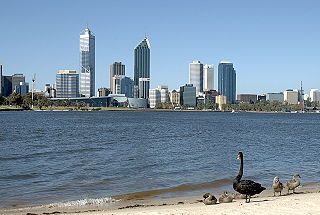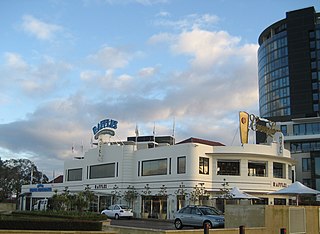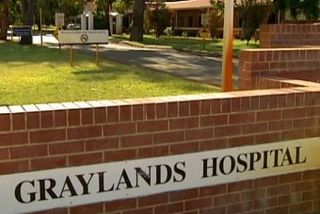Related Research Articles

The Swan River is a river in the south west of Western Australia. Its Noongar Aboriginal name is the Derbarl Yerrigan. The river runs through the metropolitan area of Perth, Western Australia's capital and largest city.

Fremantle is a port city in Western Australia, located at the mouth of the Swan River in the metropolitan area of Perth, the state capital. Fremantle Harbour serves as the port of Perth. In 2016, Fremantle had a population of approximately 29,000. The Western Australian vernacular diminutive for Fremantle is Freo.

Albany is a port city in the Great Southern region in the Australian state of Western Australia, 418 kilometres (260 mi) southeast of Perth, the state capital. The city centre is at the northern edge of Princess Royal Harbour, which is a part of King George Sound. The central business district is bounded by Mount Clarence to the east and Mount Melville to the west. The city is in the local government area of the City of Albany. While it is the oldest colonial, although not European, settlement in the territory that today is Western Australia, predating Perth and Fremantle by over two years, it was a semi-exclave of New South Wales for over four years until it was made part of the Swan River Colony.

Toodyay, known as Newcastle between 1860 and 1910, is a town on the Avon River in the Wheatbelt region of Western Australia, 85 kilometres (53 mi) north-east of Perth on Ballardong Noongar land. The first European settlement occurred in the area in 1836. After flooding in the 1850s, the townsite was moved to its current location in the 1860s. It is connected by railway and road to Perth. During the 1860s, it was home to bushranger Moondyne Joe.

Claremont is a western suburb of Perth, Western Australia, on the north bank of the Swan River.

The City of Melville is a local government area in the southern suburbs of the Western Australian capital city of Perth, east of the port city of Fremantle and about 12 kilometres (7.5 mi) south of Perth's central business district. The City covers an area of 52.73 square kilometres (20.36 sq mi) and had a population of about 98,000 as at the 2016 Census.

Applecross is a riverside suburb of Perth, Western Australia, bounded by Canning Highway and the Swan River. It is located within the City of Melville.

Mount Eliza is a hill that overlooks the city of Perth, Western Australia and forms part of Kings Park. It is known as Kaarta Gar-up and Mooro Katta in the local Noongar dialect.

Point Walter is a point on the Swan River, Western Australia, notable for its large sandbar that extends into the river. It is located on the southern shore of Melville Water, and forms its western end. Point Walter is located in the suburb of Bicton, approximately 12 kilometres (7 mi) south of the Perth central business district, and 7 kilometres (4 mi) north-east of Fremantle, and is on the opposite side of the river to the suburbs of Mosman Park, Peppermint Grove, and Dalkeith.

Point Belches is a small point on the south side of Swan River, Western Australia, about 250 metres (820 ft) east of The Narrows within the area known as Perth Water. The land is part of the South Perth Esplanade, and the water off the point is used as a commercial water skiing area.

Melville Water is a significant section of the Swan River in Perth, Western Australia. It is located west and downstream of Perth Water, from which it is separated by the Narrows Bridge.

Perth was founded by Captain James Stirling in 1829 as the administrative centre of the Swan River Colony. It gained city status in 1856 and was promoted to the status of a Lord Mayorality in 1929. The city inherited its name due to the influence of Sir George Murray, then Member of Parliament for Perthshire and Secretary of State for War and the Colonies.

East Fremantle is a suburb of Perth, Western Australia, located 13 kilometres (8.1 mi) south-west of the central business district. The suburb is mainly residential, and is coterminous with the Town of East Fremantle local government area.

George Thomas Temple-Poole was a British architect and public servant, primarily known for his work in Western Australia from 1885.

Raffles Hotel is located at the corner of Canning Highway and Canning Beach Road in the Perth suburb of Applecross, Western Australia. It is a two-storey hotel designed in the Inter-War Functionalist style and is one of the few examples of a hotel in this style surviving in the Perth metropolitan area. Earlier named the Canning Bridge Hotel, it has operated continuously as a licensed hotel since at least 1896. For over 50 years until 2002, it was owned by Australian nightclub owner and property developer Abe Saffron, whose plan to demolish the hotel was successfully opposed by the Art Deco Society of Western Australia in a ten-year campaign.

William Burden Hardwick, often referred to professionally as W.B. Hardwick, was an Australian architect who from 1917 until 1927 was Principal Architect of the Public Works Department in Western Australia. The Encyclopedia of Australian Architecture refers to Hardwick as being "well known for continuing the high standards of design in public buildings established during the gold boom, particularly in hospitals, schools and post offices throughout the state".

Sunset Hospital is a former hospital and aged care facility located in Dalkeith, Western Australia. Built in 1906 under the name Claremont Old Men's Home, it once housed up to 750 men. The design of the house was based on a military model, made from large stone blocks quarried from local limestone with accommodation for 400 men. It included an infirmary and a hospital.

Swanbourne Hospital is a heritage listed former mental hospital located in Mount Claremont, Western Australia. Built in 1904, it was the largest stand-alone psychiatric hospital in Western Australia for much of the twentieth century until its closure in September 1972. The hospital was originally known as Claremont Hospital for the Insane, Claremont Mental Hospital and Claremont Hospital. Following the closure of Claremont Hospital in 1972, the original 1904 section of the hospital functioned as the Swanbourne Hospital until 1985. The site has been vacant since 1986.

Graylands Hospital is Western Australia's largest mental health inpatient facility, and the only public stand-alone psychiatric teaching hospital. It is located on a 10-hectare (25-acre) site in Mount Claremont, in a suburb formerly known as Graylands, after which the hospital was named. The hospital has 178 beds, including 30 beds in the Frankland Centre, and 320 nurses on staff.
Whitby Falls Hospital is a former hospital for the mentally ill located in Mundijong, Western Australia. Until its closure in 2006 it was the longest operating facility in Western Australia for the care and treatment of mental illness.
References
- ↑ Heritage Council of Western Australia – Interim Registry (accessed:09-03-2007)
- ↑ Western Australian Museum – Living In The City (accessed:09-03-2007)
- ↑ "Aboriginal History in the City of Melville". City of Melville. Archived from the original on 4 March 2016. Retrieved 19 July 2015.
- ↑ "Mental Reception Home". The Daily News. Perth, WA. 21 December 1923. p. 10. Retrieved 27 May 2019.
- ↑ "Heritage Council of WA – Register of Heritage places" (PDF). 2007. Retrieved 5 May 2012.
- ↑ "Mental Reception Home at Point Heathcote". The West Australian . Perth, WA: National Library of Australia. 17 November 1928. p. 6. Retrieved 13 February 2013.
- ↑ "Official Opening of the Heathcote Mental Home". The West Australian . Perth: National Library of Australia. 23 February 1929. p. 7. Retrieved 13 February 2013.
- ↑ Laud, Peter.(1999) "Park of perfection". The Sunday Times , 21 March 1999, Sunday section, p.3-5
- ↑ Heathcote Heritage Precinct opened by Premier after $6m redevelopment of hospital site Media statement, Premier of Western Australia, P00/39, 19 March 2000
- ↑ Western Australian Parliament – Heathcote Hospital Site (reservation) Bill 2001 (accessed:09-03-2007)